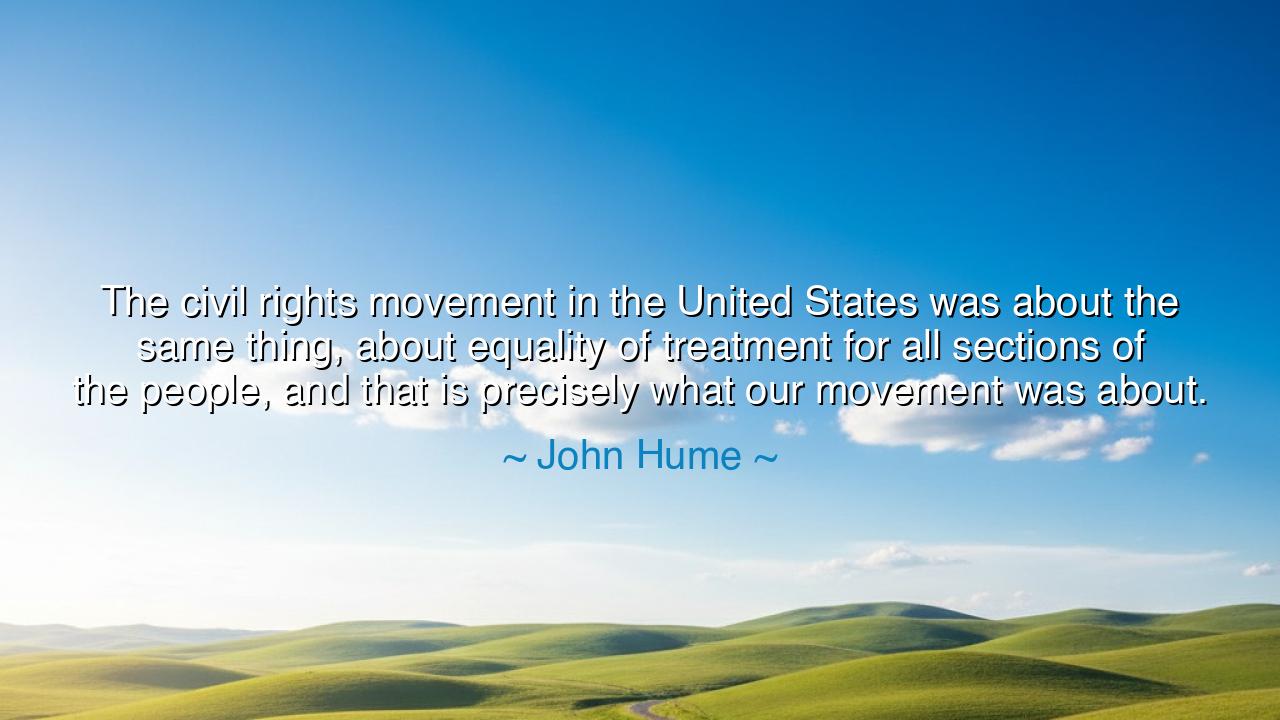
The civil rights movement in the United States was about the same
The civil rights movement in the United States was about the same thing, about equality of treatment for all sections of the people, and that is precisely what our movement was about.






When John Hume declared, “The civil rights movement in the United States was about the same thing, about equality of treatment for all sections of the people, and that is precisely what our movement was about,” he wove together the struggles of two lands separated by an ocean but bound by the same longing for justice. His words carry the rhythm of solidarity, teaching us that the cry for equality of treatment is not confined to one people or one age but is the eternal demand of humanity wherever oppression casts its shadow.
The meaning of this quote is clear and profound: the struggle for civil rights in America and the struggle for civil rights in Northern Ireland were twin flames born of the same fire. In the United States, Black men and women demanded dignity, the right to vote, and the right to be treated not as second-class citizens but as equals under law. In Northern Ireland, Hume and others sought the same for Catholics who faced discrimination in housing, employment, and representation. Both movements declared with one voice that justice cannot be divided: what is owed to one is owed to all.
The origin of Hume’s words rests in the tumult of the 1960s and 1970s, when Northern Ireland was torn by division and violence. Inspired by the courage of Martin Luther King Jr. and the civil rights marchers of the American South, Hume called for nonviolent resistance, for peaceful protest, for courage without hatred. He saw in the American example not a distant story but a mirror: oppressed communities rising up, not to conquer others, but to claim their rightful share of dignity and equality. Thus his movement was shaped by the same principles of nonviolence, unity, and moral resolve.
History offers us a vivid example in the march across Selma’s Edmund Pettus Bridge in 1965. There, peaceful protestors were beaten by police for demanding the right to vote. Their suffering, broadcast across the world, awakened consciences and hastened reform. In a similar way, when Northern Irish citizens marched for housing rights and fair voting systems, they too were met with violence. Yet their resilience drew attention to their plight and placed the cause of equality at the heart of international concern. These stories, though born in different lands, reveal the same truth: oppression may take many forms, but the struggle against it is always united.
The wisdom of Hume’s words is that he refuses to isolate one movement from another. He teaches that the cry for justice is universal, and that when one people rises against injustice, they inspire others to do the same. The victories of African Americans in the United States gave courage to the oppressed in Northern Ireland. The struggle of the Irish, in turn, taught the world again that nonviolence can be a sword sharper than hatred, cutting through centuries of division.
The lesson for us is that justice is indivisible. To care only for one’s own people while ignoring the suffering of others is to betray the very principle of equality. Just as Hume saw the kinship between American and Irish struggles, so must we see the kinship of all who are oppressed today. Whether the battle is for racial equality, for gender justice, or for the dignity of the poor, they are all one movement, branches of the same tree whose root is the longing for fairness.
What then must the listener do? Study the struggles of the past, and let them guide your steps in the present. If you see injustice, speak against it. If you see discrimination, resist it. Do not imagine that your fight is isolated, for every battle for dignity strengthens the larger cause of humanity. Seek always to build bridges, as Hume did, between peoples and movements, so that no one struggles alone.
Remember always: equality of treatment is not a gift from the powerful, but a birthright of every human being. John Hume’s words remind us that the fight for justice is never the story of one people alone—it is the story of us all. And when we honor that truth, when we link arms across borders and generations, then the dream of equality will not be a dream but a living reality, strong as stone, enduring as hope.






AAdministratorAdministrator
Welcome, honored guests. Please leave a comment, we will respond soon